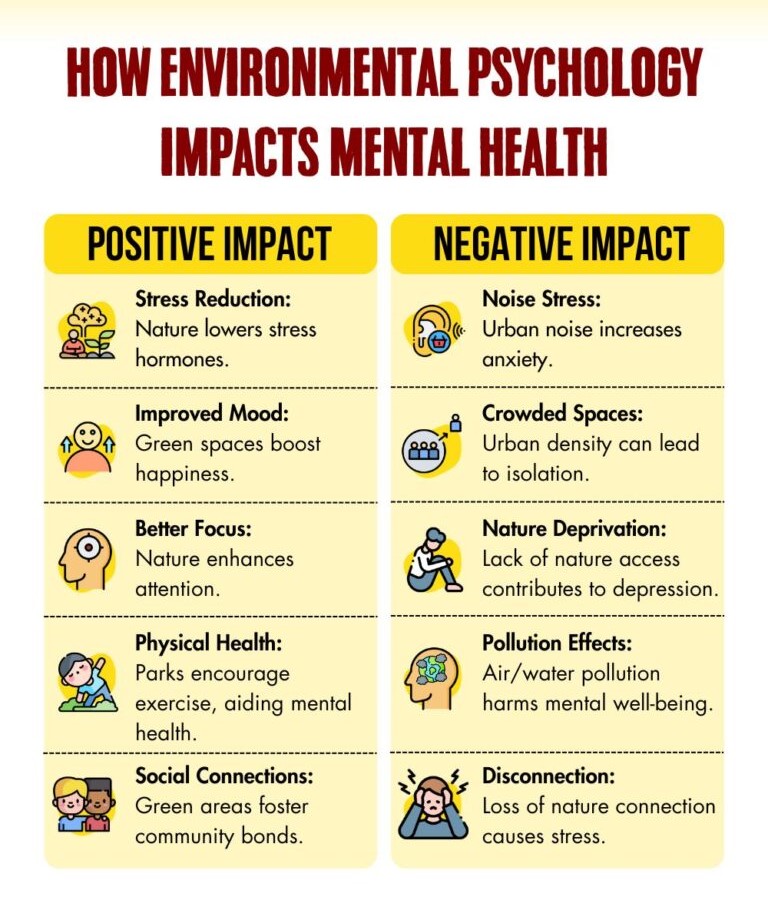Environmental psychology delves into how our surroundings impact our behavior and well-being. It guides mental health care by designing healing spaces and utilizing nature-based therapies (like forest therapy and outdoor activities) to improve mental health.
What Is Environmental Psychology?
Environmental psychology is a field that studies the interplay between individuals and their surroundings 1 Kühn, T., & Bobeth, S. (2022). Linking environmental psychology and critical social psychology: Theoretical considerations toward a comprehensive research agenda. Frontiers in psychology, 13, 947243. https://doi.org/10.3389/fpsyg.2022.947243 . It examines how the physical environment affects people’s behavior, emotions, and well-being, as well as how individuals’ perceptions and behaviors can, in turn, shape their environments.
The nature of environmental psychology is interdisciplinary 2 Stokols D. (1978). Environmental psychology. Annual review of psychology, 29, 253–295. https://doi.org/10.1146/annurev.ps.29.020178.001345 , drawing from psychology, sociology, environmental science, architecture, urban planning, and other fields. It seeks to understand the relationship between people and their environments, including natural settings, built environments (like cities and buildings), and virtual environments (such as online spaces).
Environmental Psychology Examples
- Impact of natural light on productivity in office spaces 3 Benz, A., Formuli, A., Jeong, G., Mu, N., & Rizvanovic, N. (2022). Environmental psychology: Challenges and opportunities for a sustainable future. PsyCh journal, 11(5), 767–773. https://doi.org/10.1002/pchj.585
- Effect of green spaces on stress reduction in urban areas
- Influence of noise levels on sleep quality in residential areas
- Design of hospitals to promote healing and well-being
- Proximity to nature and its effects on mental health
- Behavior changes in response to recycling programs
- Perception of safety in well-lit and well-maintained neighborhoods
- Impact of virtual environments on social interaction and well-being
Read More About Stress Here
Environmental Factors That Affect Mental Health
Several 4 Sörqvist P. (2016). Grand Challenges in Environmental Psychology. Frontiers in psychology, 7, 583. https://doi.org/10.3389/fpsyg.2016.00583 environmental factors that affect mental health, including:
- Access to green spaces
- Noise pollution
- Crowding
- Natural light
- Urban design
- Lack of nature
- Air quality
- Social support
- Safety
- Physical activity
How Environmental Psychology Impacts Mental Health

Environmental psychology has a dual impact on mental health 5 De Gregorio, E., Caffaro, F., Pirchio, S., Tiberio, L., & Carrus, G. (2023). Editorial: Current trends in environmental psychology, volume I. Frontiers in psychology, 14, 1228180. https://doi.org/10.3389/fpsyg.2023.1228180 , offering both positive and negative influences. On the positive side, it emphasizes the restorative power of nature, with access to green spaces and natural settings known to reduce stress and promote relaxation.
Therapeutic landscapes, such as gardens in healthcare facilities, contribute to healing and recovery. Additionally, biophilic design principles integrating natural elements like light and plants into buildings can enhance mood and well-being. Healthy urban planning, featuring walkable cities with parks and bike lanes, encourages physical activity, which is beneficial for mental health.
Conversely, negative environmental psychology examples on mental health include noise pollution in urban areas, leading to increased stress and sleep disturbances. Crowded environments can exacerbate feelings of anxiety and diminish well-being, while a lack of green spaces in cities can contribute to higher stress levels. Poor lighting within buildings may affect mood negatively, potentially resulting in symptoms of depression and fatigue. Living in unsustainable environments, marked by environmental degradation, can foster a sense of hopelessness and exacerbate mental health issues.
Read More About Depression Here

Application Of Environmental Psychology In Mental Healthcare
Environmental psychology examples in mental healthcare involves designing therapeutic spaces that promote healing 6 Nasar J. L. (2015). Advances in Environmental Psychology. Behavioral sciences (Basel, Switzerland), 5(3), 384–387. https://doi.org/10.3390/bs5030384 and well-being, such as calming nature-inspired environments in hospitals, implementing stress-reducing elements like natural light and greenery, and creating supportive communities within treatment facilities to improve patients’ mental health outcomes.
Environmental psychology in mental healthcare includes utilizing nature walking/bathing 7 Harper, N. J., Fernee, C. R., & Gabrielsen, L. E. (2021). Nature’s Role in Outdoor Therapies: An Umbrella Review. International journal of environmental research and public health, 18(10), 5117. https://doi.org/10.3390/ijerph18105117 , forest therapy 8 Hansen, M. M., Jones, R., & Tocchini, K. (2017). Shinrin-Yoku (Forest Bathing) and Nature Therapy: A State-of-the-Art Review. International journal of environmental research and public health, 14(8), 851. https://doi.org/10.3390/ijerph14080851 , and adventurous play 9 Owens, M., & Bunce, H. L. I. (2022). The Potential for Outdoor Nature-Based Interventions in the Treatment and Prevention of Depression. Frontiers in psychology, 13, 740210. https://doi.org/10.3389/fpsyg.2022.740210 as therapeutic interventions for specific mental health disorders. Nature walking and forest therapy have been shown to reduce symptoms of anxiety and depression, improve mood, and enhance overall well-being by connecting individuals with the calming and restorative effects of natural environments.
Read More About Anxiety Here
Adventurous play, such as outdoor activities and challenges 10 Dodd, H. F., & Lester, K. J. (2021). Adventurous Play as a Mechanism for Reducing Risk for Childhood Anxiety: A Conceptual Model. Clinical child and family psychology review, 24(1), 164–181. https://doi.org/10.1007/s10567-020-00338-w , can be used to treat conditions like ADHD and conduct disorders by providing opportunities for physical activity, risk-taking in controlled settings, and developing problem-solving skills in natural settings, contributing to improved focus and behavior regulation.
Takeaway
Environmental psychology illuminates the profound impact of our surroundings on human behavior, emotions, and well-being. It emphasizes the importance of creating supportive, nature-inspired environments to foster positive mental health outcomes and enhance overall quality of life.
At A Glance
- Environmental psychology studies how surroundings affect behavior and well-being.
- It is an interdisciplinary field, drawing from psychology, sociology, environmental science, and architecture.
- It guides mental health care through designing healing spaces and using nature-based therapies.
- Positive impacts of environmental psychology include restorative power of nature and biophilic design principles.
- Its negative impacts include noise pollution, crowded environments, and lack of green spaces.
Frequently Asked Questions (FAQs)
1. How Does Environmental Psychology Improve Human Life?
Environmental psychology examples improve human life by studying how the physical environment influences emotions, behavior, and well-being.
2. What Is The Current Scope Of Environmental Psychology?
The current scope of environmental psychology includes research on how design, nature, and urban spaces impact mental health, productivity, and social interactions.
3. Does The Environment Affect Human Behavior?
Yes, the environment significantly affects human behavior, influencing everything from mood and stress levels to decision-making and social interactions.















